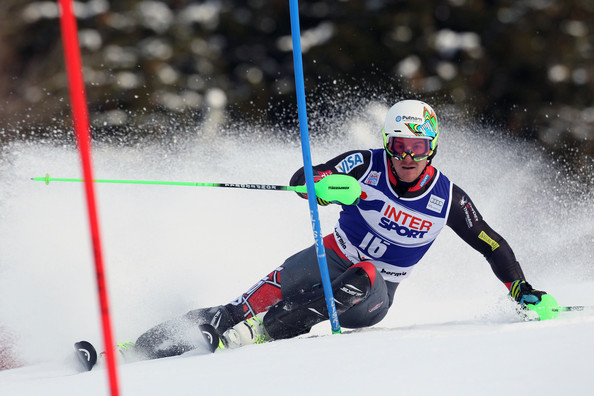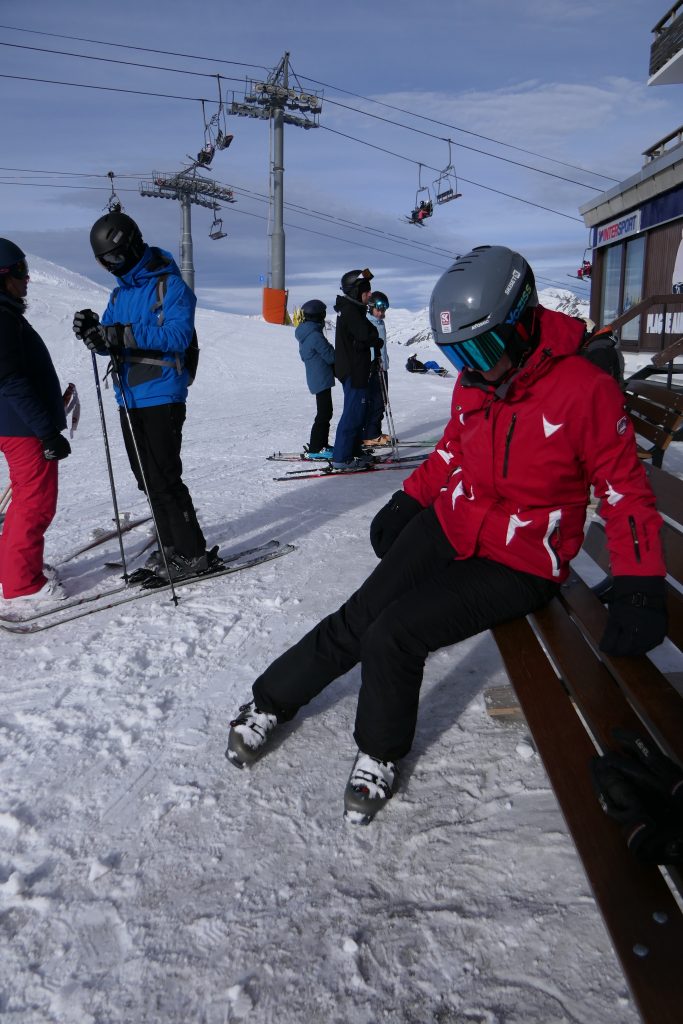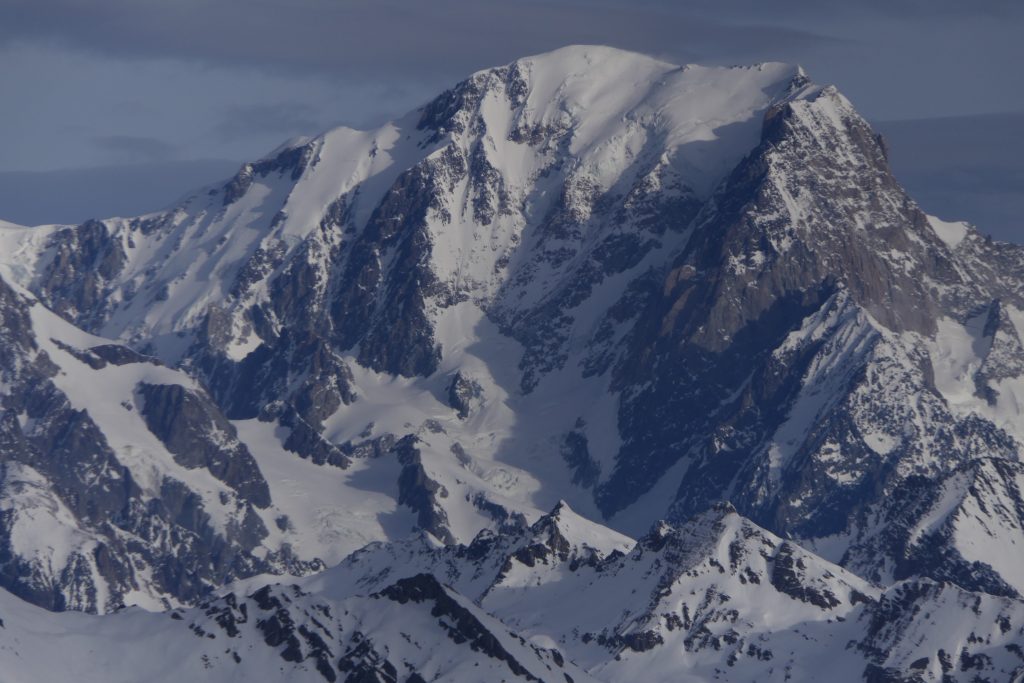- Individual Feedback
- Everting the Feet
- Pivoting
- Combining Dynamics and Pivoting
- Advanced Dynamics
Individual Feedback
Ollie had a classic blockage to progress which initially only appeared to be a twisting of the foot/ski into the new turn – this being only a symptom not a cause. The reason this frantic and sometimes disastrous action was taking place was actually due to staying with all the weight on the edged downhill ski defensively and so trying to stem the unweighted uphill ski into a turn – guaranteeing great difficulty.
Once this obstacle was identified and eliminated great progress was made rapidly. (Sorry for running out of time before capturing your skiing on video)
Diana’s solution to steeper turning was to rotate the whole body into the turn. Rotation prevents the centre of mass from going towards the centre of the turn – obliterating hip angulation and creating a lot of tension (often called “tractor turns”) – hands held too low and legs constantly flexed. All of that was corrected step by step due to Diana’s excellent awareness of her own body.
Everting the Feet
When the skis are parallel the feet still “diverge” (as if skating) inside the ski boot – each foot being turned outward (everted). This obviously isn’t visible. This is to combat the tendency to twist the foot inwards to”turn” the ski directly -a mistake which flattens the ski and causes loss of grip.

Eversion of the feet is always useful – here it was used initially to address Ollie’s stemming before it was realised that the stemming had another cause.
Pivoting
Pivoting was taught to both Ollie and Diana as a way of building confidence and awareness of using the uphill ski with only a lateral movement and control of the centre of mass – the ski effectively sideslipping into the turn (like spreading butter with a knife).
After learning skating turns on the flat this is the way beginners should learn to turn for dealing with gradients. They should be assisted if required – by holding a ski pole at the side of the instructor and being physically led through all the moves – just like someone being led in a dance. Eventually the skill is assimilated due to the body being fed the correct feeling repeatedly. Some athletic beginners can cope with this manoeuvre on their own.
The reason for this pivot is to develop fall-line skiing skills. It’s a “braking” form of turn which gives great control over speed – because of the skis only being used on uphill edges. The other important element of this pivot is that both feet are kept downhill of the skier (vertically below the skier) which is not only a fun and playful way to ski but is critical for safety on dangerous steeps such as in couloirs. Most people are totally brainwashed in the skiing world into believing that a ski only turns because of its inside edge with its sidecut. Well it does, but not all of the time. The ski can also turn while on its outside edge during the first half of a turn. If someone has already worked on a forward diagonal sideslip then they already partly know the mechanism for this.
The skier has to stand on the uphill ski only, lifting the lower ski off the snow. The foot should feel pressure on its outside edge but the adductor muscles of this leg should be pulling in the downhill direction. The ski will remain on its outside edge (due to the lateral support of the ski boot shaft preventing the ski from flattening). The downhill pole should be planted for support and so when the lower ski is lifted the body weight should be partially transferred to the pole. This requires the skier to face downhill and tilt forwards from the hips (angulation). Place the centre of mass downhill as much as possible with the use of support from the ski poles. Try to keep the ski on its uphill edge while the centre of mass moves downhill of it. The use of the pole here is to support and guide the centre of mass – which then pulls the ski tip downhill along with it. (In dynamics skiing with forward motion of the ski the pole is not required because the support for the centre of mass comes from the lifting up power of the ski itself. This is why pole planting is only associated with pivoting and not with dynamic skiing – where only a pole touch at most is required when entering a turn)
The adductor muscles of the outside leg continue to be engaged to allow the centre of mass to pull the front of the ski downwards in a sideslip into a turn. This trains the correct muscular coordination – pulling inwards towards the turn centre with the adductor muscles.
To check that the adductor muscles are being used the “Pole Stopper” exercise is useful. For this exercise I place a ski pole between the tips of the two skis. The skier lifts a ski a few inches off the snow and then pulls the tip against the pole. If the adductor muscles are being used then as the tip is blocked the tail should swing inwards at the back. If the tail swings outwards then the it’s the muscles on the outside of the leg (abductors) being used to push and twist rather than the adductors (inside of the leg) being used to pull or tension the leg.
When the pivot starts the skier (centre of mass) has to move downhill slightly from the ski but not too much because the ski must remain on the uphill edge for as long as possible. Moving the body too much downhill would change the ski edges far too quickly – for this effect the ski must be allowed to sideslip right from the beginning. The ski will change edges when it is in the fall-line, onto the new “inside” uphill edges for the last part of the turn. All the time – from start to end of the turn the skier needs to pull inwards and tension the adductors.
Completing the turn correctly requires the skier to avoid body rotation and to have the body in an anticipated and angulated stance, ready for another pole plant at the start of the next turn.
Combining pivot and dynamics
The basic “pivot” initialises a turn from the uphill ski – uphill (outside) edge. In dynamic skiing (with skis running forward) the same edge provides a platform for pushing off early to start the next turn. The ski will start the turn with a slight pivot action naturally and the engaged uphill edge will guarantee there is no slipping outwards of the ski during the “push” – assuring a clear directing of the centre of mass into the new turn. This flexed “uphill” leg permits a strong push which has to be executed consciously and deliberately.
We developed a “garlands” exercise that was very effective – when traversing extending the uphill leg while on the uphill edge and toppling downhill just enough to start a slight turn – then relaxing the leg to return to the traverse – then repeat until the final extension launches a turn.
The centre of mass drops toward the centre of the new turn during the leg extension – it’s not a “popping up” – it drives the centre of mass down toward the ground.
Advanced Dynamics


You do not “face downhill” – Instead you are parking one cheek of your bum on the snow/bench!
The centre of mass drops down as the outside leg extends. (the ski lifts you back up -when it’s moving forward)


